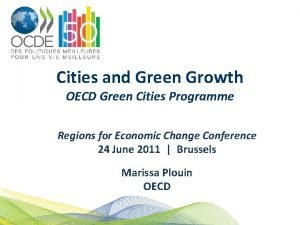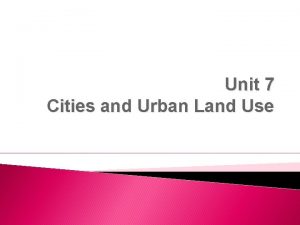Learning from success What fast growing cities in



















- Slides: 19

Learning from success: What fast growing cities in Europe and globally do Austin Kilroy Senior Economist World Bank Group

Three questions: 1. How much local economic growth can we expect? 2. What does it look like? 3. How do cities help it happen?

Solving problems during implementation Changsha, 2005

Solving problems during implementation Changsha, 2015

Gaziantep, 2005

Gaziantep, 2015 • Light-manufacturing firms export to 175 countries around the globe. • Exports increased tenfold from $620 million in 2002 to $6. 2 billion in 2013. • Recorded an average of 6. 3 percent in annual GDP growth from 2005 -2012. • 3. 6 percent in annual employment growth.

1. How much growth can we expect? Local regions can grow very fast Miasto Wroclaw (Poland) Legnicko-Glogowski (Poland) Trnavský kraj (Slovakia) Gliwicki (Poland) Nitriansky kraj (Slovakia) Klaipedos apskritis (Lithuania) Zilinský kraj (Czechia) Kauno apskritis (Lithuania) Constanta (Romania) Lõuna-Eesti (Estonia) Piotrkowski (Poland) Prahova (Romania) Brasov (Romania) Salaj (Romania) Giurgiu (Romania) GDP per capita in 2004 GDP per capita in 2014 Average yearly growth in income (2004 -2014) € 7 500 € 7 200 € 6 800 € 5 700 € 5 600 € 5 200 € 5 100 € 3 700 € 4 800 € 2 700 € 3 300 € 2 100 € 1 700 € 17 600 € 15 800 € 15 700 € 13 000 € 12 200 € 13 100 € 12 300 € 11 200 € 10 500 € 10 200 € 9 800 € 9 000 € 5 900 € 4 900 8. 9% 8. 2% 8. 7% 8. 4% 7. 9% 8. 8% 9. 2% 11. 7% 8. 1% 7. 8% 13. 8% 10. 6% 10. 9% 11. 2% Population (2014) 633 000 453 000 558 000 478 000 686 000 328 000 690 000 585 000 684 000 321 000 594 000 750 000 551 000 220 000 278 000

1. How much growth can we expect? Average Annual Jobs Growth 25% 16% Average Household Income Growth 15% 14% 20% 12% 10% …but economic performance varies a lot. Average Annual GDP growth 17% gap p. a. 15% 22% gap p. a. 8% 5% 6% 4% 22% gap p. a. mean 10% mean 0% 5% 2% 0% -5% 0% -2% -4% Minimum Maximum -5% -10% Minimum Maximum

2. What does growth look like? 6 Annual employment growth, 2005 -2012 Driven by goods & services that can be traded (e. g. agribusiness, tourism, light manufacturing, ICT), rather than by shops or local services. 7 5 How…? • Expand the local economy. • Increase productivity. 4 3 2 Tradable goods & services Non-tradable goods & services 1 0 Top 10 percent of cities Other 90 percent of cities

2. What does growth look like? Sectors of the economy change as income rises. Some industries will grow faster than others.

3. How do cities help it happen? City rankings are everywhere. . .

3. How do cities help it happen? …but they are higher for richer cities– not correlated with growth rates.

National government 3. How do cities help it happen? Cities have multiple levers, policies, and investments available Cities have multiple levers available District / city / local governments Private sector 13 13 Source: World Bank (2015) Competitive Cities for Jobs and Growth: What, Who, and How

3. How do cities help it happen? Policies and investments for the needs of local firms and investors • Support to firms in navigating the city’s regulations • Business-friendly zoning and land-use policies • Streamlined business licensing • Online ‘e-government’ services • Special governance regimes for organized industrial zones/parks • Worker training and talent attraction programs • Improvements to the educational system • University-business networks • R&D grants • Subsidized land or office space for priority industries • Concerted effort to ensure essential services available for industries • Co-location of similar firms (clustering) • Market intelligence and business information • Investment facilitation, promotion and aftercare • Financial incentives targeted to priority industries or sectors

3. How do cities help it happen? This means talking to your firms and investors (Example: Gaziantep, Turkey) Credible individuals with a track record of success (e. g. President of Sanko Holdings, one of the largest firms in Turkey). Local firms: • Rivals, but come together on common interests, (e. g. infrastructure upgrades) Two business chambers: • Large professional staffs, budgets, and political influence. • Help determine priorities, build consensus, and advocate on behalf of business. Municipality: • Supportive, not dominating • Business-friendly City Council: • Forum for information sharing and consensus. • Members: 80% private sector, universities, or civil society • Several thematic working groups issuing recommendations.

3. How do cities help it happen? In practice… >> 1. City / local authority may be in a good position to: • Diagnose strategic segment(s); • Convene economic stakeholders; • Lobby regional and federal governments. 2. What differs between countries: • …. scope for action (legal and practical); • …. devolution legislation; • …. capability of city staff for economic analyses.

1 7 3. How do cities help it happen? …with some very common mistakes • Capture by incumbent s • Too many Strategy priorities • Weak link from analysis Budget Mismatc h with declared strategy • Lack of accountabi Actions lity • Risks not anticipated

Three questions: 1. How much local economic growth can we expect? Varies a lot– cities shrinking as well as growing super-fast. 2. What does it look like? Exportable goods and services. Industries growing at various speeds. 3. How do cities help it happen? Vocabulary of levers to apply– configured according to economic opportunities. Consultations with companies and investors. And attention to budget and implementation.

Austin Kilroy Senior Economist World Bank Group akilroy@worldbank. org
 Growing success ontario
Growing success ontario Growing success report card comments
Growing success report card comments Growing up too fast
Growing up too fast Your child's success or lack of success
Your child's success or lack of success Your child's success or lack of success
Your child's success or lack of success Burger industry analysis
Burger industry analysis Acid fast vs non acid fast
Acid fast vs non acid fast Acid fast vs non acid fast
Acid fast vs non acid fast Cuadro comparativo e-learning m-learning b-learning
Cuadro comparativo e-learning m-learning b-learning Success criteria examples for students
Success criteria examples for students Learning intentions examples
Learning intentions examples Learning intentions and success criteria examples
Learning intentions and success criteria examples Learning intentions and success criteria for mathematics
Learning intentions and success criteria for mathematics Learning intention example
Learning intention example Jilong xue
Jilong xue Types of growing media
Types of growing media Objectives of vegetables
Objectives of vegetables Pv of perpetuity formula
Pv of perpetuity formula Growing up in the indus valley
Growing up in the indus valley Rock candy hypothesis
Rock candy hypothesis





































